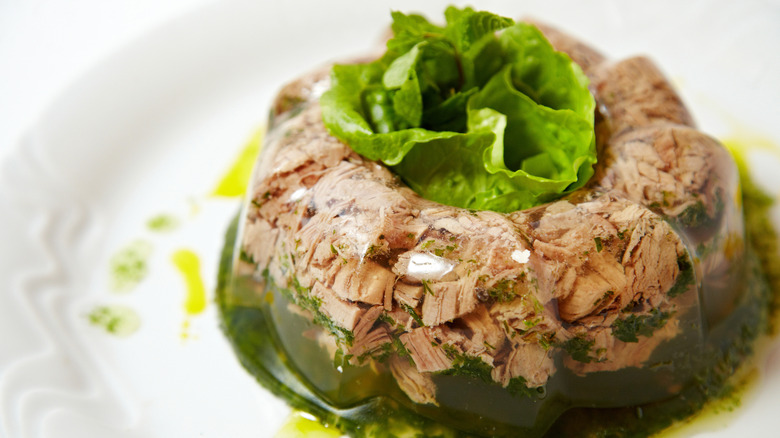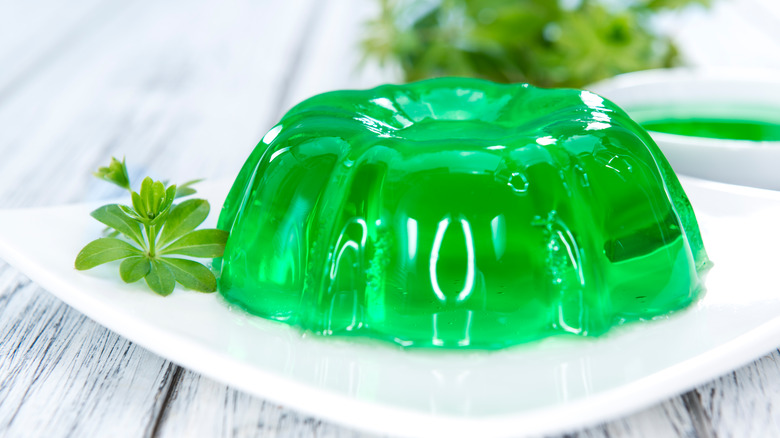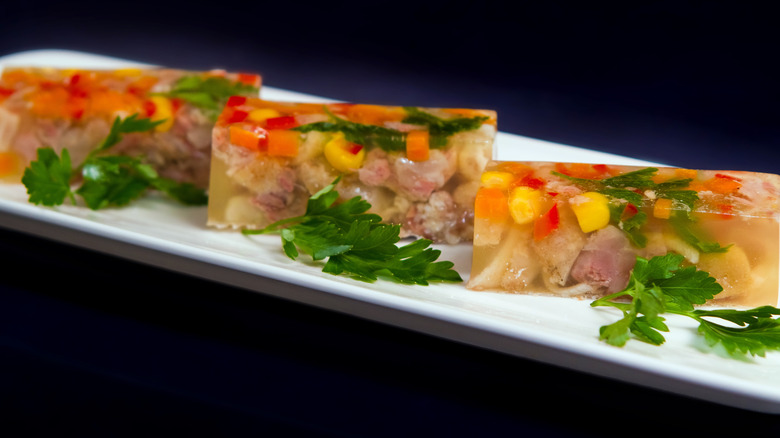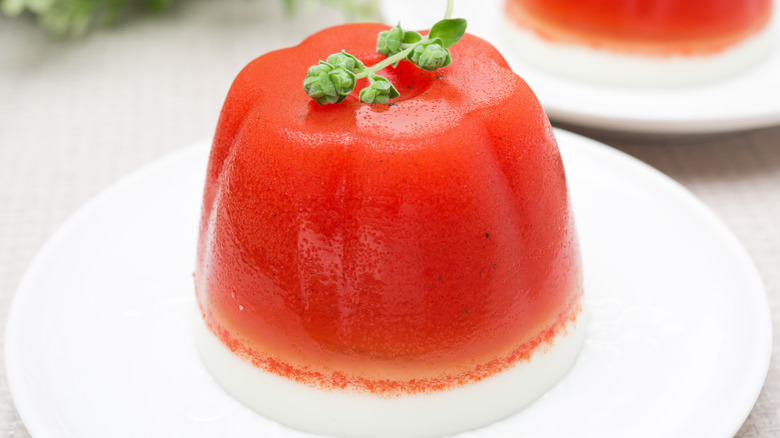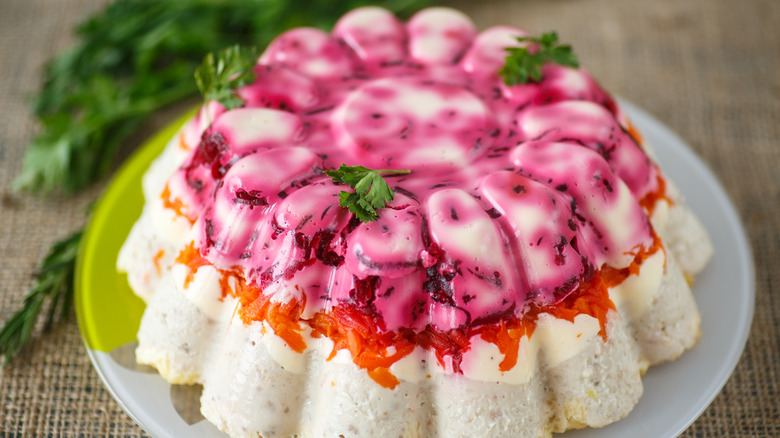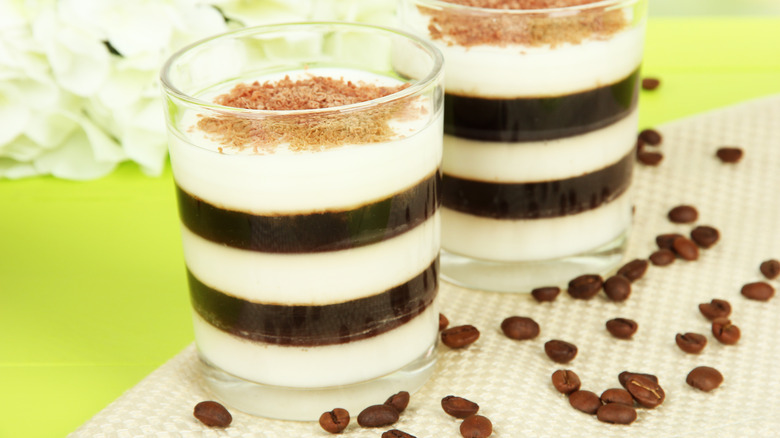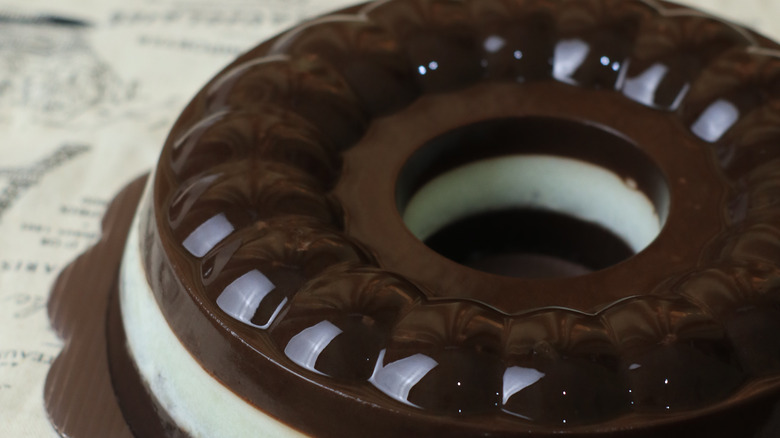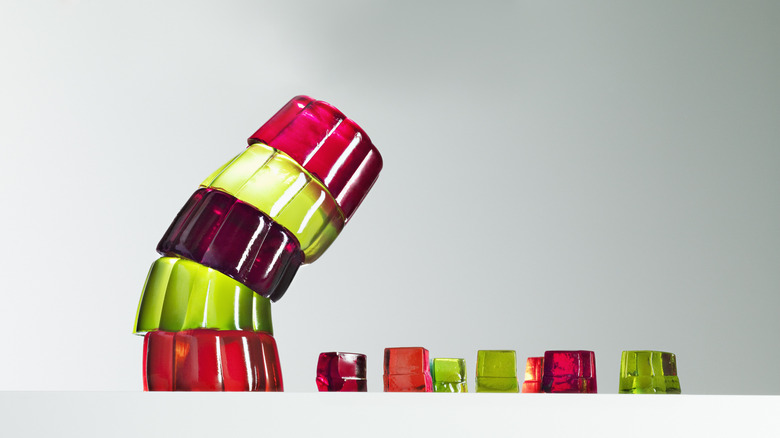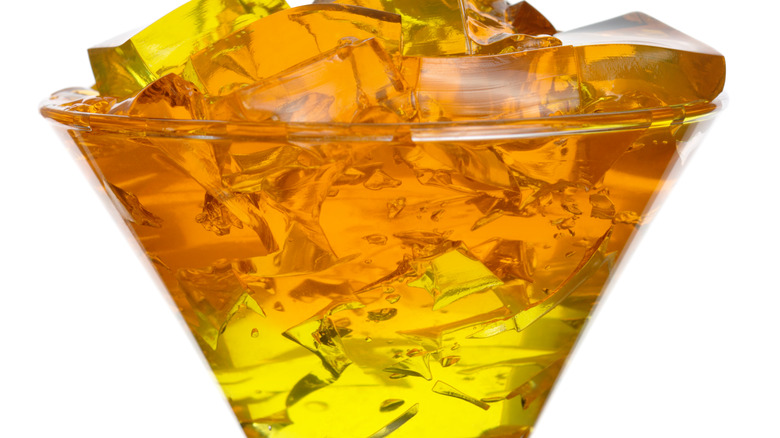9 Of The Wildest Discontinued Jell-O Flavors
"There's always room for Jell-O" was the long-used marketing slogan for the brand most associated historically and globally with gelatin. It is a reliable and popular dessert — or snack, depending on how you choose to enjoy it — offering a variety of familiar fruit flavors. Jell-O has long been a staple in American family's pantries — at least since it became known as the country's most famous dessert in 1904. The treat comes fully sweetened or sugar-free and can be homemade out of the box or purchased in snack cups. Among the best-selling Jell-O flavors are lemon, lime, orange, cherry, strawberry, and grape.
Traditionally, Jell-O is made with gelatin which is produced by boiling the bones and hides of farmed animals – then it is cured, treated, and filtered for a few weeks until the collagen in it can be dried into a powder. If the process seems a bit strange or difficult to follow, we haven't even begun to hit the surface. So, here are some of the most audacious and just plain weird flavors of Jell-O that have come and gone over the years.
Celery
From a modern lens, it is hard to associate Jell-O with any taste other than sweet. It is a dessert mix that produces a final product that tastes like a fruity candy, like Skittles or Starburst. But Jell-O is not naturally that sweet — its flavors are added to gelatin, a byproduct of meat production. That substance on its own has no inherent flavor. Likewise, celery, a vegetable made mostly of water, also has very little to no flavor. This makes Jell-O's '60s introduction of a celery variety incredibly confusing and almost nonsensical.
Nonetheless, celery did have its purpose in the production line. Like using chicken stock instead of water to impart slightly more flavor to a homemade soup, celery Jell-O provided a subtle uptick in taste over its unflavored counterparts. It gave off a slight vegetable flavor that served as a foundation for non-dessert Jell-O salads and side dishes served at dinner parties. Unsurprisingly, this flavor was discontinued after only a short period of availability. Still, it is certainly not one of the better flavors — or the strangest, for that matter.
Italian Salad
Experimenting with new flavors should feel like an afterthought for a company that has long produced a variety of flavored gelatin products. Since 1897, when Jell-O launched with four flavors — lemon, orange, raspberry, and strawberry — they have consistently put out new products for its customers to try. The first few flavors after its launch were of the fruity variety, which makes sense, given they had already tested similar flavors. However, what does not make sense is what came next.
In the mid-'60s, Jell-O introduced its salad options. So, next on our list is the ever-confusing Italian Salad flavor. It is hard to know what was going through the minds of those in charge of distributing new flavors at Jell-O. It's possible they were just throwing out a number of different options until one or two landed with its consumer. Or, perhaps, it was more strategic and aligned with an era several of us can't understand today.
Because this flavor came and went from the Jell-O line so quickly and long ago, we can't tell you what it tasted like. However, it does conjure up images of Olive Garden's unlimited Italian house salad. For now, everything about this Italian Salad Jell-O flavor is mysterious and a little bit odd.
Seasoned Tomato
In addition to the salad flavors Jell-O had in stores, it also sold a tomato-flavored option. Not only did this option taste like tomatoes, but the flavor also came with added common kitchen herbs and spices to really shake things up. The Seasoned Tomato and Italian Salad flavor hit the market in 1965 and was either loved or dismissed by consumers.
Since tomato is botanically a fruit and those flavors remain the most popular today, it is possible this option was more of a hit than some of Jell-O's other introductions. But given the fact that it is no longer sold and that tomatoes are enjoyed in savory dishes, sauces, and condiments like salsa, spaghetti sauce, and ketchup, the fame was probably short-lived. Seasoned Tomato Jell-O could have tasted like ketchup, but in a watered-down kind of way and in the form of a translucent gel-like texture. Overall, it is really not that surprising that Seasoned Tomato Jell-O didn't make it long after its 60s debut.
Mixed Vegetables
If cookbooks from the '50s and '60s were any indication, an aspic would really impress guests at any dinner party. This once-exotic food was made by setting gelatin into a mold with other foods suspended inside. Reading it out loud or for the first time, this can certainly come off as a strange idea. Even weirder and potentially less appetizing, food journals of those decades once suggested the addition of vegetables to aspics. It is tricky and not necessarily crowd-pleasing to mix the gum-like and elastic consistency of Jell-O with the crunchier texture of vegetables.
To make things even more interesting, instead of using plain gelatin, Jell-O helped aspic enthusiasts hang their cut veggies inside a vegetable-flavored suspension. For a brief time in the '60s, Jell-O sold a line of "salad" gelatins – which included a Celery option and a Mixed Vegetables option. Why or how these dishes made it to any dinner party table and were major hits is pretty remarkable.
Coffee
Jell-O works best and is most successful when it sticks to fruity flavors, like those in the citrus or berry families. After all, those are the ones that have stuck around supermarket shelves the longest. The stranger, more outlandish flavors have faltered — like its Pure Coffee Flavor introduced in 1918. While it was only released in certain regions and not for a long time, it is clear it wasn't as big of a hit as the company maybe hoped it would be.
When Jell-O released its coffee-flavored food, it was potentially trying to accomplish two things at once: succeed at offering a dessert option and a coffee option. However, this product fell short of being both a sweet treat and a robust pick-me-up. While this option is no longer available by Jell-O itself, a quick Google search will reveal a few brands selling their own twists and iterations on the flavor. Similarly, there are plenty of recipes on the web that will satisfy those interested in chewing their coffee instead of drinking it.
Chocolate
For the most part, Jell-O has had a pretty good track record with its chocolate flavors. The chocolate-flavored pudding mix made cooking the dessert at home as simple as heating milk, adding it to a powdered mix, and stirring. Jell-O's pre-made pudding cups have been a lunchbox staple for decades. At one point in time, chocolate was one of the flavors produced in a line of Jell-O ice cream powders that would turn regular milk into an ice cream-like frozen dessert. One box would produce around 1½ quarts of delicious ice cream.
While this one might not seem so strange, chocolate-flavored Jell-O does not nearly sound as enticing as the pudding or ice cream versions. The flavors commonly associated with gelatin are completely different from those invoked by chocolate pudding or ice cream. Gelatin desserts promise a rubbery sensation, quick dissolution, and a mild, sometimes-sweet flavor.
Chocolate works best when it is creamy, velvety, smooth, and can linger on the tongue. In a gelatin form, chocolate does not come off as rich as it can be. Since chocolate is strong and full of flavor, it simply does not mesh well with traditional Jell-O, which is why this flavor made it on this list.
The Mr. Wiggle line
Regular varieties of Jell-O already back a substantial serving of sugar. A standard serving of orange-flavored Jell-O that comes from the box contains about 19 grams of sugar. Although sugar tends to be enough to entice most children, the makers of Jell-O didn't think that was enough. To take things a step further, the already kid-friendly line released a new set of products in 1965 – it was branded the Mr. Wiggle line.
Jell-O marketed the flavors with animated TV commercials starring a zany, hyperactive red blob of sentient gelatin named Mr. Wiggle. It was these dessert mixes that played up the fun, wobbly nature of prepared Jell-O. The ads featured an ongoing relationship between Mr. Wiggle and the nefarious Sweet Tooth Sam.
The commercials also openly and unabashedly used Mr. Wiggle content to sell the candy-tasting gelatin in flavors like Gumdrop Grape, Candycorn Orange, Jellybean Strawberry, Lollypop Lime, Rockcandy Raspberry, and Candyball Cherry. Although those are all variations of standard Jell-O flavors in production today, the Mr. Wiggle foods were just a lot sweeter. Amazingly, the Mr. Wiggle flavors didn't last long — parents probably found regular Jell-O to be sufficiently sweet and effective at getting their children amped up before bedtime.
Sparkling White Grape
If Jell-O — a simple and affordable powder that comes in a cardboard box — was once seen as a fancy or impressive dish, then the Sparkling White Grape Jell-O flavor would have to be viewed as the brand's natural attempt at top-shelf status. Based on the name and the fact that it was marketed as "the Champagne of Jell-O," it was a clear attempt to hone in the same flavors as champagne.
The product boasted a mild grape flavor that, when cooked up, turned into a translucent, yellowish-brown color. It also promised the effect of effervescent or fizzy bubbles — directions called for the product to be made not only with water as usual but a combination of water with seltzer, club soda, or ginger ale. The carbonation imparted that champagne-like fizz with none of the alcoholic buzz, of course. The product was only available for a limited time in 1997, a promotional item to commemorate Jell-O's 100th anniversary — a champagne toast, if you will.
Cotton Candy
Cotton candy is a dessert or a snack people typically enjoy while wandering around a carnival or at the circus. It is a simple novelty consisting entirely of sugar that has been spun and heated. Then a bit of brightly colored food dye is added to give the final product some enticement. The process of making cotton candy turns the sweet stuff into a delightful treat that can feel prickly at first but is then rendered smooth as it instantly melts on your tongue. Arguably, it is more of a texture than it is a flavor.
However, it is still familiar, fun, and nostalgic to many, likely helping prompt the creation of the Cotton Candy Jell-O. The flavor, which was only available for a limited time, was introduced as a collaboration of sorts with the DreamWorks' animated "Trolls" movie. Based on a long popular line of dolls, the characters sport wild hair that looks like cotton candy, so this was a quick conceptual leap to cotton candy-flavored Jell-O. Yet, the final gelatin product does not look at all like cotton candy, nor does it offer its signature texture. Cotton Candy Jell-O is more or less sugar-flavored Jell-O that will probably just remind the consumer of eating troll hair. And if that's not strange, then what is?
